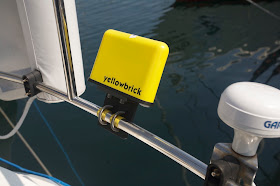Function: AIS charting and information
Rating: **
Cost: $11.99
AIS can be used by the long distance cruiser or the weekend coastal boater to add a level of safety. AIS Radar is a reasonably priced app that will give you some basic AIS functionality.

AIS stands for Automatic Identification System. Large international commercial ships and all passenger ships are required by law to broadcast AIS data to prevent collision and increase safety while at sea. It is estimated that there are about 40,000 ships currently carry AIS class A equipment. The new Class B AIS standard was introduced in 2007 and created a new generation of low cost AIS transceivers. AIS will not replace conventional radar but can be used to assist the yachtsman in collision avoidance.
AIS is becoming more popular with the advent of cheaper software and hardware. AIS uses VHF frequencies to broadcast and receive the AIS data and targets. AIS Radar can display data received from marine AIS transponders such as the ExNC 101 Class B AIS Transponder over a WiFi network. For AIS transponders or receivers without built-in WiFi support, an external serial WiFi adapter such as the SEAMate1A Lite, the Brookhouse iMux, the Roving Networks RN-370 or the Digi Connect® Wi-SP can be used.
Data from public AIS networks can optionally be displayed from the Internet.
Features:
- Radar like display of AIS data and targets.
- Course, heading and speed information of targets
- Variable radar display range
- Multiple symbols for AIS targets. Class A and class B transponders.
- Computes CPA, closest point of approach and TCPA, time to closest point of approach.
- Multitouch gestures to select display range
- Display modes of heading up, course up and north up
- Options to hide slow moving targets from radar display
- List of AIS targets and display all information about the targets
- Viewer for AIS safely related broadcast messages
Four soft keys, Radar, Targets, Messages and Settings are used to navigate within the app. The radar like display shows real time AIS targets. Targets are shown with different symbols depending on if they are AIS A or B. The app allows different radar ranges to be selected with multi touch gestures.
The Targets display gives you a list of AIS targets which can be selected to give more details. The name, call sign, type, status, speed, course and heading can all be viewed.
The price of app at $11.99 is reasonable if your just looking for a stand alone AIS app. The one draw back is that it does not display the targets on a marine chart. There are several charting apps that do also include AIS displays. If you have the iNavx app the AIS display is integrated into the charting display. I have a list of the Top 5 Best AIS apps listed on my blog. Check them all out and see which one fits your needs.














